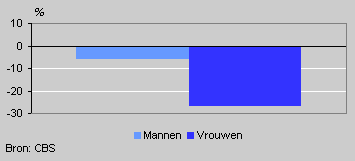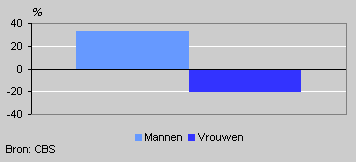Divorce reduces women's purchasing power substantially

After a divorce, most men are better off financially than when they were married. Their purchasing power rises by an average 7 percent. Women on the other hand lose 23 percent of their purchasing power on average after a divorce, according to the results of Statistics Netherlands’ Income Panel Survey for the years 1989-2000.
Children influence change in purchasing power
Divorce has different financial consequences for men and women. This is partly connected with the presence of children and with whom they live after the divorce.
Change in purchasing power after divorce for couples without children, 1989-2000

If a couple does not have children, the purchasing power of both the woman and the man decreases after a divorce. Men lose 6 percent on average. As men have a higher average income, the loss of common income hits women hardest: their purchasing power is reduced by an average 27 percent.
Change in purchasing power after divorce when children stay with the mother, 1989-2000

In cases where children stay with their mother after a divorce, the purchasing power of men increases by an average 33 percent, in spite of the fact that they have to pay alimony. Women’s purchasing power decreases by 21 percent.
Even when children stay with their father after a divorce, men’s purchasing power increases. This increase is smaller though, 6 percent, than in cases where children stay with their mother.
Change in purchasing power after divorce when children stay with the father, 1989-2000

Childless women are best off
Childless women suffer the greatest loss of purchasing power after divorce. But they still have a significantly higher purchasing power than divorced mothers. This is because women with children usually have a lower income before divorce than women without children. After a divorce, many mothers end up with an income at the level of income support.
Anne Marthe Bouman